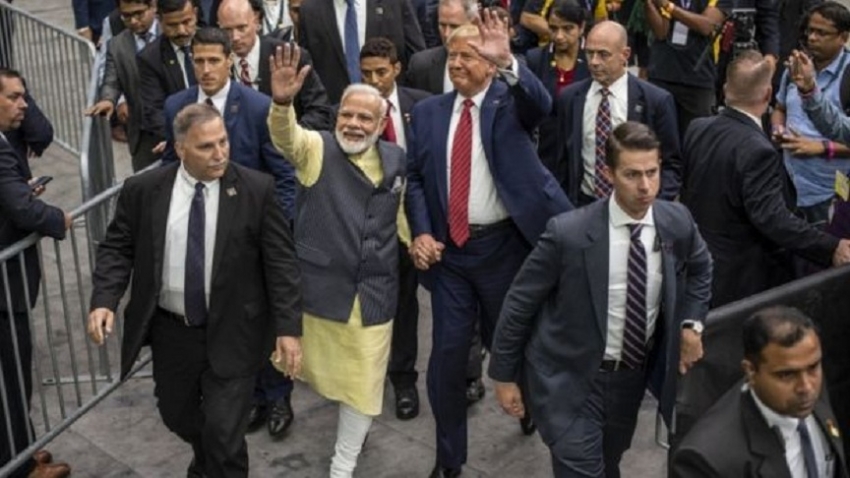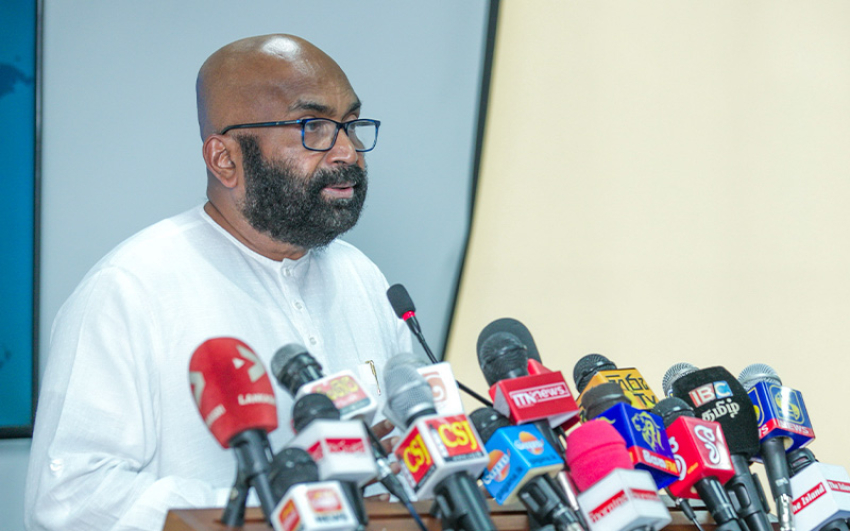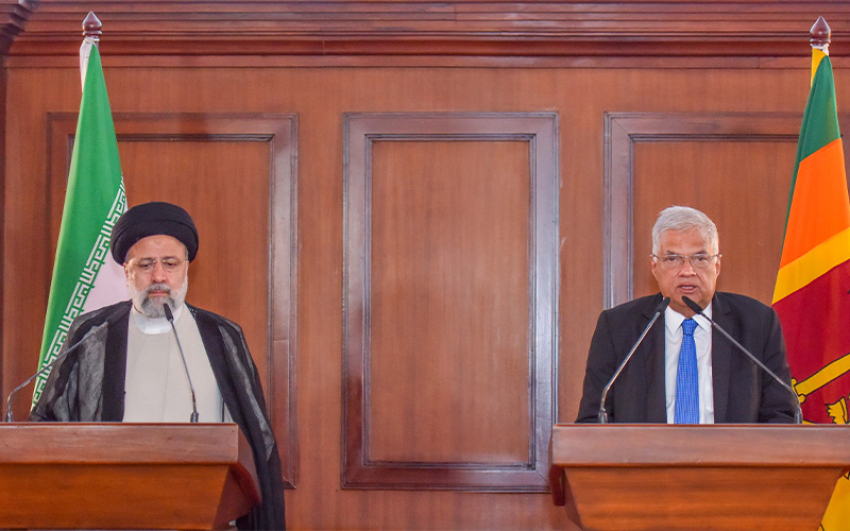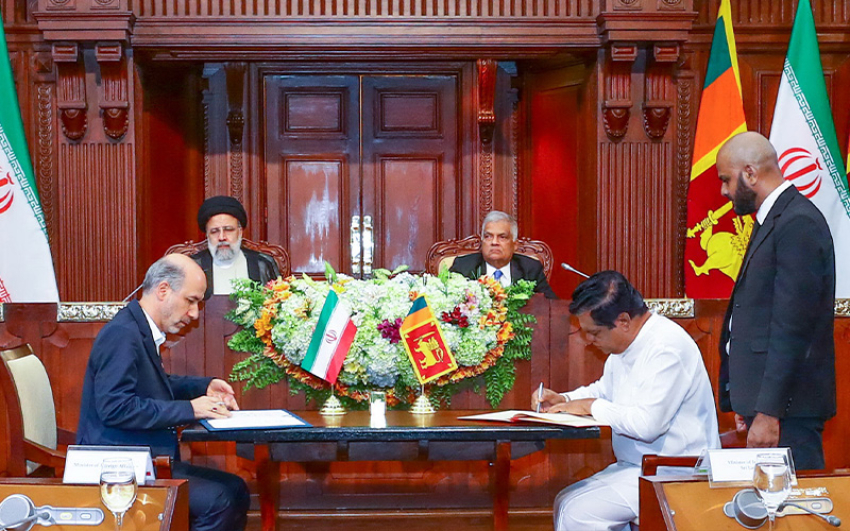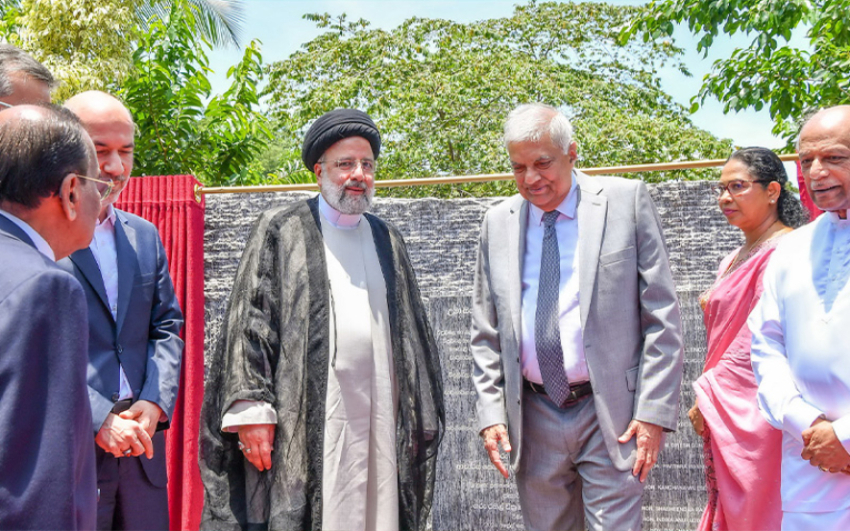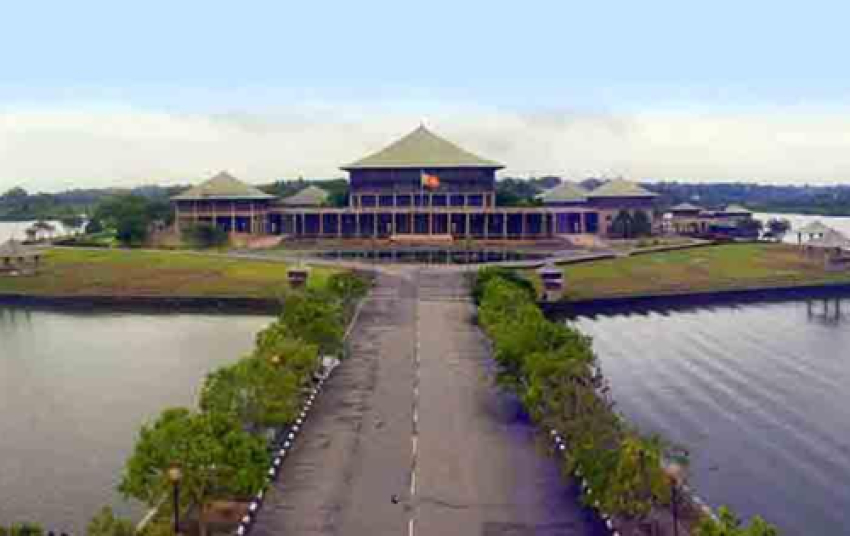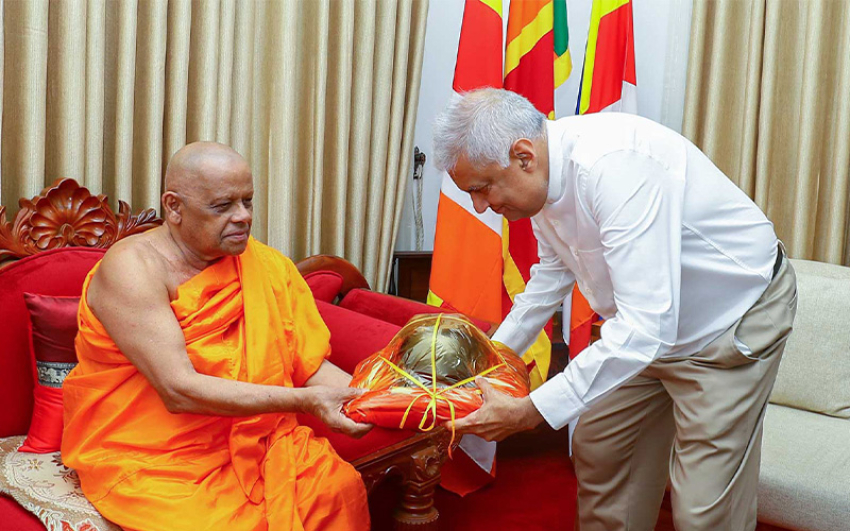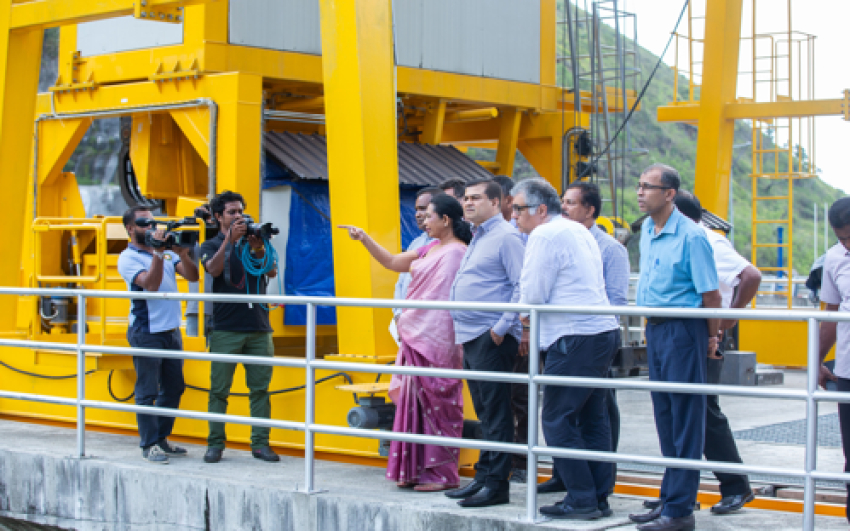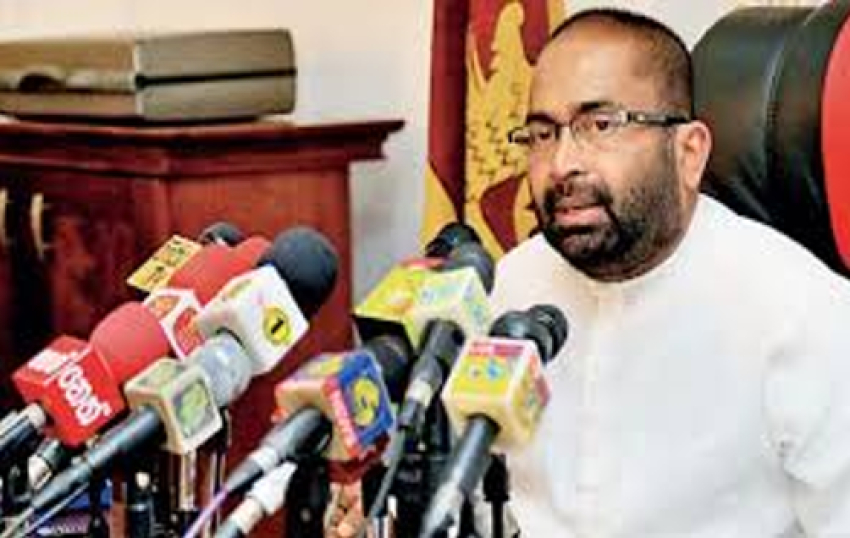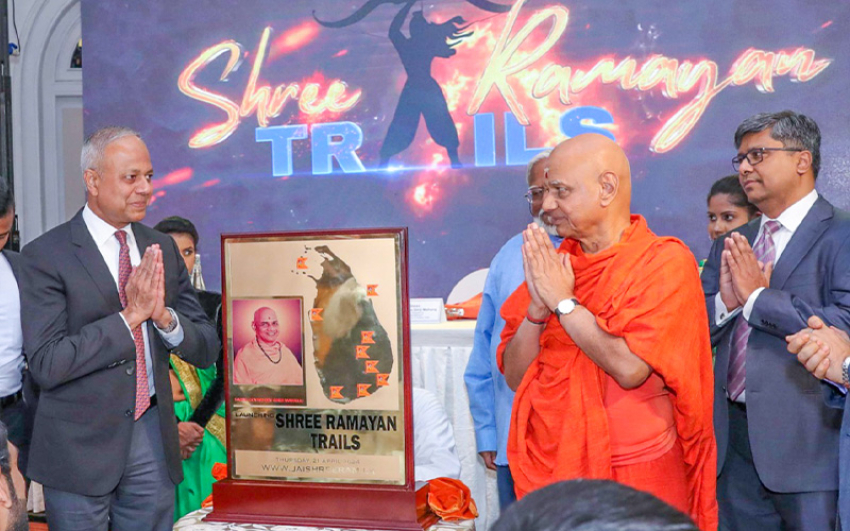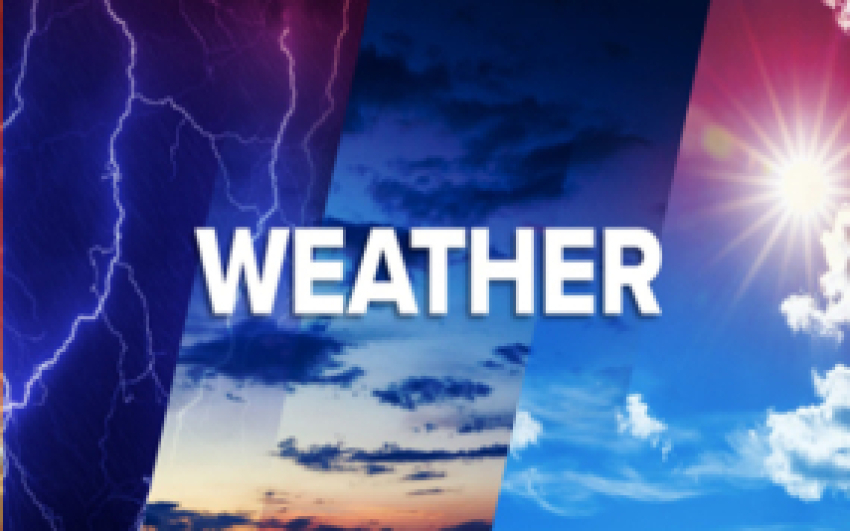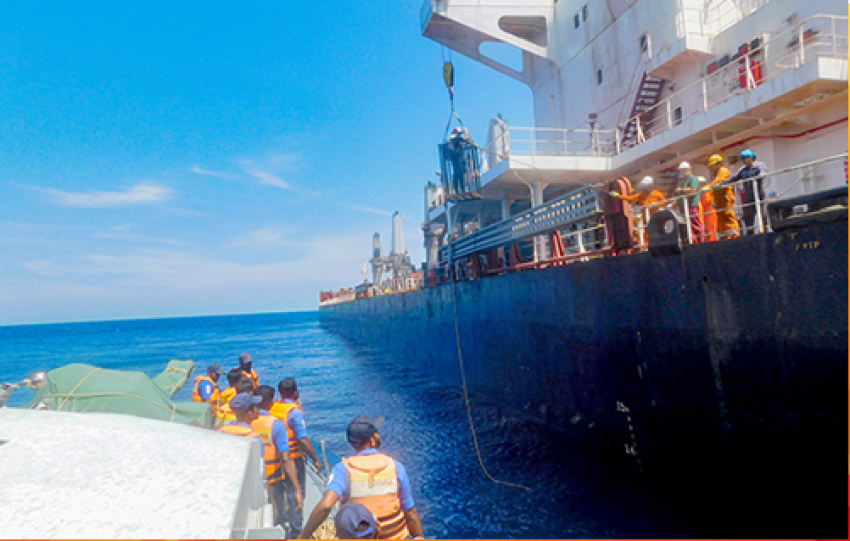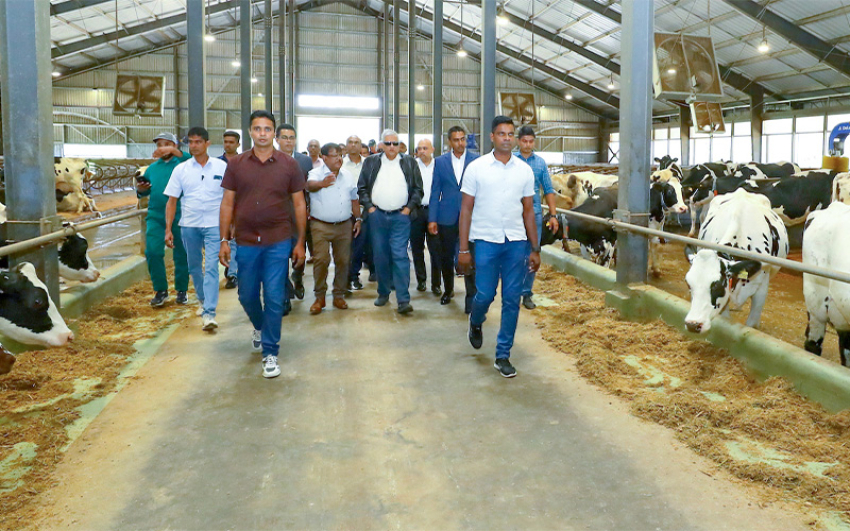US President Donald Trump and Indian Prime Minister Narendra Modi exchanged warm words of friendship in Texas at a rare mass rally for a foreign leader.Around 50,000 people gathered for what Mr Trump called a "profoundly historic event" on Sunday in Houston.The "Howdy, Modi!" event was billed as one of the largest ever receptions of a foreign leader in the US.Mr Modi, however, may face a frostier reception at the UN General Assembly.He is likely to face criticism over tensions in Indian-administered Kashmir, which he stripped of its special status last month, promising to restore the region to its "past glory".The region has been in lockdown for more than a month with thousands of activists, politicians and business leaders detained.Trade talks and the UN General Assembly are on the Indian prime minister's agenda during his week-long visit to the United States.Pakistani Prime Minister Imran Khan, who has been the most vocal international leader to oppose India's Kashmir move, is also in the US for the UN conference. Like Mr Modi, he will have a one-on-one meeting with Mr Trump on the sidelines of the summit.
Why Trump appearance signals importance of IndiaA 90-minute show, featuring 400 performers, warmed up the crowd before Mr Modi and Mr Trump shared the stage."I'm so thrilled to be here in Texas with one of America's greatest, most devoted and most loyal friends, Prime Minister Modi of India," Mr Trump told the crowd.In his speech, Mr Modi said India has a "true friend" in the White House, describing Mr Trump as "warm, friendly, accessible, energetic and full of wit"."From CEO to commander-in-chief, from boardrooms to the Oval Office, from studios to the global stage… he has left a lasting impact everywhere," Mr Modi said.
Personal-touch diplomacy played to perfection This was exactly the kind of crowd size and energy President Trump loves at his rallies.Only here the chants were for Indian Prime Minister Narendra Modi and Mr Trump was the superstar invited to the party. But the crowd did not disappoint him either and greeted him with chants of "USA!", most heard at Trump rallies.The personal-touch diplomacy with Mr Modi's trademark bear hugs was played to perfection.This rally has been called a win-win for both the leaders. For President Trump, it was a chance to court Indian-Americans for the 2020 presidential election race where Texas could emerge as a battleground state. For Mr Modi, a PR triumph and picture with the president of the United States may help him shrug off the criticism over his recent strong-arm polices at home.Houston's NRG Stadium, where the event was hosted, was the first stop for Mr Modi, whose Hindu nationalist Bharatiya Janata Party (BJP) won a landslide victory in this year's Indian elections.
Greeted by a standing ovation, Mr Trump used his speech to heap praise on Mr Modi, who he said was doing a "truly exceptional job for India" and its people.Mr Trump also paid tribute to the Indian-American community, telling them "we are truly proud to have you as Americans".The US has a population of about 4 million Indians who are seen as an increasingly important vote bank in the country.Apart from Mr Trump, organisers also invited Democrats to the event - House Majority Leader Steny Hoyer was among those who spoke.The 2010 US census shows that Texas is home to the fourth-largest Indian-American population in the country after California, New York and New Jersey.Analysis of voting patterns shows the community tends overwhelmingly to support the Democrat party.
The event, dubbed "Howdy, Modi!", was attended by an estimated 50,000 people
No stranger to nationalist rhetoric himself, Mr Trump compared security at the US-Mexico border to the tensions between India and Pakistan in the tinderbox Kashmir region."Both India and US also understand that to keep our communities safe, we must protect our borders," Trump said.Donald Trump described Narendra Modi as one of America's most "loyal friends"In India, the rally was closely watched, with most mainstream media outlets running live news updates of what was transpiring on stage.The event had been making headlines for days before as well.On Twitter, many people shared instant analysis and opinions of what was taking place on the stage with the sentiment being overwhelmingly positive. Many praised Mr Modi for what they saw as his statesmanship and diplomatic acumen with a lot of praise coming in for the US president as well.No one. I repeat NO ONE understands people of India better than @narendramodi. He is pressing ALL the right buttons, linguistic diversity, confidence in ourselves, Vikas, strong borders, aspirations of young India, the world.. and the crowd is eating out of his hands. #HowdyMody
In 2016 election, Trump had got 12% of Indian-American vote. Trump came to #HowdyModi not for his love for Modi or India but to campaign for 2020 election! Trump wants Indian-American’s vote but doesn’t want them in ‘great again’ America! http://toi.in/NpnTub/a24jg via @timesofindiaThese Indians are the reason Trump couldn't ignore 'Howdy Modi' - Times of IndiaIndia News: US draws the maximum international migrants, including Indians, one of the reasons why Donald Trump attended the 'Howdy Modi' mega rally in Houston on
Modi visit to US: Trump appearance signals importance of India
By Brajesh Upadhyay
Five years ago, when Narendra Modi first stepped on US soil as India's prime minister to chants of his name and "Hail Mother India", many called it audacious.The rock star reception at New York's Madison Square Garden resembled a victory lap for a leader who had been denied entry into the US for almost a decade.This Sunday, the Indian leader will address a far bigger crowd of supporters at an event in Houston, Texas, and standing next to him will be the president of the United States - a visual that many believe will help Mr Modi shrug off some of the international criticism over his controversial move on Kashmir.The event, aptly titled "Howdy, Modi!", is expected to attract a crowd of more than 50,000, the largest gathering of Modi supporters outside India, at the NRG Stadium.he first-of-its-kind joint appearance is being hailed as a PR triumph for Mr Modi, but it also testifies to the growing importance of US-India relations."I think this was in some ways inevitable and reflects the strength of the Indian-American community," says Nisha Biswal, former Assistant Secretary of State in the Obama administration.She says it's a good thing that the president has decided to go to Texas."This relationship now transcends individuals and it transcends politics," added Ms Biswal, who now heads the US-India Business Council.The organisers, Texas India Forum, have tried to emphasise the bipartisan nature of the event by inviting prominent Democrats including the House Majority Leader Steny Hoyer, several other Congressmen, US elected officials, and governors.The choice of Houston as the spot for this rally is not surprising either.India is Houston's fourth-largest trading partner and its growing energy demand is expected to further boost the sale of American oil and gas. For India, it's also an opportunity to bring down the trade deficit with the United States - a major issue for Mr Trump.
Modi speech as he celebrates Independence Day There are also strong indications to suggest that the two countries may announce some progress toward ironing out the strong trade differences witnessed in the last year-and-a-half."If this happens, there will be talks about winning and the President would want to take credit for that," says Tanvi Madan, India Project director at Washington's Brookings Institute.For President Trump, who himself is a big fan of spectacles and huge crowds, the mega event also provides an opportunity to court Indian-Americans for next year's Presidential election.Talking to reporters, the President said: "He's got a big crowd coming and I guess the crowd just got a lot bigger because they just announced - he asked, would I go, and I will go".With a population of more than 3.2 million, Indian-Americans comprise 1% of the US population and are also among the wealthiest communities in the US.
New York gives star treatment to Indian PM Modi
By Nick Bryant
This arena has hosted Elvis Presley, Bruce Springsteen and Mohammed Ali. Bill Clinton came here in 1992 to be crowned the Democratic presidential nominee.But the superstar welcome was reserved for Modi, a one-time pariah, who up until recently could not even have walked through US immigration at John F Kennedy International Airport let alone step on stage at such a sacred venue.The colour and exuberance of the world's largest democracy was fused with the stage management of a US political convention.From the red, white and blue balloons primed to drop on to the stage at the finale to the Obama-style portrait that became the logo of the rally, everything was intricately choreographed to present the new face of India's controversial leader.Downplay the Bollywood, had been the message to the organisers, the Indian-American Community Foundation, from the prime ministerial office in Delhi.But even Bollywood with the sound turned down is an assault on the senses. There were dancers, singers and even a speed-painter who knocked off a portrait of the bearded and bespectacled leader with the haste of a graffiti artist trying to avoid the NYPD.
Indian dancers entertained the audience in Madison Square GardenThey were supposed to be warm-up acts, not that the capacity audience needed rousing. A spill-over crowd of some 800 supporters watched on big screens at Times Square.To chants of "Modi, Modi" the Indian prime minister made his entrance dressed in a saffron-coloured jacket, with his hands clasped together in the traditional "Namaste" greeting. But such was the melee, with a phalanx of security guards providing a protective cordon, that the scene was reminiscent of a prize fighter shuffling slowly towards the ring.This was a rebranding exercise, both national and personal. He wanted to show that he was not an ogre, the Hindu nationalist hardliner who was banned from entering the US in 2005 by the Bush administration for his alleged complicity in sectarian violence in his home state of Gujarat.He also wanted to portray himself as the leader of a nation that would soon rival America.Speaking from a lectern on a revolving circular stage that allowed everyone to see him front on, Modi spoke with confidence and swagger about how this would not only be the Asian century but also the Indian century.'I have a dream'Joking that he understood visa problems, he promised to make it easier for members of the Indian diaspora to return home, a sure-fire crowd-pleaser. They should "join hands to serve our mother India".Telling the audience "I have a dream", he evoked the civil rights leader the Reverend Dr Martin Luther King and Mahatma Gandhi.On a lighter note, there was a neat one-liner about how a country once known for its snake charmers had become a hi-tech haven known for its proficiency with a mouse.But the biggest applause came when he described his extraordinary rise from a humble tea-seller to the leader of a sixth of humanity, the sort of up-by-your-bootstraps personal narrative that always goes down well in America.Missing from the event, of course, was the controversial backstory that led to him being barred from America for almost a decade. But a crowd of protesters gathered outside Madison Square Garden, tried to remind everyone of the awfulness that unfolded in Gujarat in 2002, and his alleged part in the bloodshed.
Modi supporters were also out in New York's Times Square"Modi, the fascist," read one of the placards. "Stop spreading hate in the name of Hinudism," screamed another. "Modi, Modi, you can't hide, you committed genocide," was the chant.Modi, oblivious to the protest outside, claimed that no Indian prime minister has ever received such a warm welcome on American soil.And perhaps he is right, judging by what looked like an honour guard of US lawmakers that joined him on stage for the singing of the US and Indian national anthems. Big Washington hitters like the New York Senator Chuck Schumer and Senator Robert Menendez of New Jersey, the chairman of the foreign relations committee, were there not just to greet him but endorse him.With the cheers and music still ringing in his ears, Mr Modi moves on to Washington, where he'll receive a red-carpet welcome at the White House.The Obama administration is also prepared to forgive what happened in Gujarat, if not quite forget.
Narendra Modi: Hindu foot soldier to India's prime minister
The Bharatiya Janata Party (BJP) leader has swept to a second general election landslide. The scale of his victory stunned opponents, who'd hoped Indians wanted a change of government.Mr Modi was propelled to power after his party's first spectacular win, in May 2014.Since then, a lot has changed - not least the way he has promoted his brand of muscular Hindu nationalism and the manner in which he has been received as India's leader on the international stage.For years he was persona non grata in the US, UK and other countries because of deadly anti-Muslim riots in Gujarat state that took place on his watch as chief minister. Mr Modi has always denied allegations he could have done more to stop the bloodshed.
Modi: The man who wants 900m votesWith his track record of economic success in Gujarat, Mr Modi fought in 2014 with the slogan "sabka sath, sabka vikas" (together with all, development for all).This time round, the BJP made nationalism and national security its main election planks, and in many ways the result was a referendum on this strategy, and more widely on his leadership.Mr Modi's first term as PM was a mixed bag of hits and misses amid concerns over rising Hindu nationalism, a slowing economy and violence against India's Muslim minority.Landmark schemes his government launched include cheap cooking gas for the poor, a nationwide Goods and Services Tax, a health insurance scheme for the poor and a new bankruptcy and insolvency law.His decision to promote and fund the construction of toilets in villages across the country to end open defecation was largely praised - although persuading people to use them remains a work in progress.Mr Modi also promised to carry out economic reforms and boost job creation before he came to power. But he has not been able to fully deliver on these promises.
Mr Modi is contesting from Varanasi in Uttar Pradesh In fact, his controversial decision to ban 500 and 1,000-rupee notes - as part of a crackdown on corruption and illegal cash holdings - badly hurt the economy, particularly the informal sector that largely relies on cash transactions. Following his sudden announcement on 8 November 2016, the country was thrown into chaos. The following weeks saw a shortage of new notes and people struggled to deposit their old notes in the banks.And the BJP's Hindu nationalist drive has also drawn criticism for Mr Modi. During his tenure, many BJP-governed states banned the consumption and sale of beef. The cow is considered holy by Hindus.There was shock when a Muslim man was lynched in 2015 for allegedly storing beef in his fridge. Other Muslims have been attacked and beaten by cow-vigilante groups.A February 2019 report from Human Rights Watch found that between May 2015 and December 2018, at least 44 people - 36 of them Muslims - were killed across 12 Indian states. About 280 people were injured in more than 100 incidents across 20 states over the same period.Mr Modi remained silent whenever such incidents happened, which was perceived by many as tacit support for rising intolerance.His decision to buy 36 Rafale fighters jets aircraft for the Air Force has also been controversial. Opposition parties accuse him of corruption in the deal - a charge he has denied.
Many Indians celebrated Mr Modi's decision to send Indian jets into PakistanBut these issues were largely absent from the BJP's campaign pitch. It's nationalism that has become the mainstay for the party's election strategy.It stems from Mr Modi's decision to send fighter jets inside Pakistani territory in response to a deadly militant attack in Indian-administered Kashmir, that brought the two nuclear-armed states to the brink of war.Mr Modi will have been aware there was no room for complacency. Voters handed the BJP humiliating defeats - in the Rajasthan, Madhya Pradesh and Chhattisgarh state elections - late last year. And he also faced a rebellion by some of the party's senior-most leaders who feel that the BJP has been "emasculated" under his leadership.Narendra Modi was born in 1950, the third of six children, to a family of grocers in what is present-day Gujarat.He went on to serve as chief minister of Gujarat from 2001 to 2014, and became regarded as a dynamic and efficient politician who helped make the western state an economic powerhouse.But he also is accused of doing little to stop the 2002 religious riots when more than 1,000 people, mostly Muslims, were killed - allegations he has consistently denied. However, he has never expressed any remorse or apologised to Muslims.
Mr Modi became an international pariah after the riots - the US denied him visas and the UK cut off all ties with him. But his victory in 2014 helped him get reintegrated into the global political mainstream.
Modi and Trump held bilateral talks in WashingtonHe travelled far and wide, and addressed massive gatherings of non-resident Indians in the US and the UK. Analysts say it was his way of announcing his arrival on the global stage.His foreign policy, however, has also been a mixed bag. He has re-energised India's relations with strategically important Central Asian countriesBut relations with China remain strained despite several high-profile bilateral visits. And he hasn't been able to carry over the Obama-era warmth in Washington-Delhi relations to the Trump administration.
Mr Modi's rise from chief minister of Gujarat to India's PM was dramatic and took many by surprise.A brilliant orator, the party's poster boy faced stiff internal differences when the BJP named him as its candidate for PM.For years, his critics said he could never be prime minister because of the riots.
His personal life also came under scrutiny, with critics accusing him of deserting his wife, Jashodaben. It was only in the run-up to the 2014 elections that he publicly admitted for the first time that they were married.He was 17 when the arranged marriage took place but the couple barely lived together and have been estranged for years.Mr Modi has always avoided questions about his personal life amid suggestions he wished to appear celibate to his Hindu nationalist base.Analysts say one reason for his strength remains the support he enjoys among senior leaders in the right-wing Hindu Rashtriya Swayamsevak Sangh (RSS).The RSS, founded in the 1920s with a clear objective to make India a Hindu nation, functions as an ideological fountainhead to a host of hardline Hindu groups - including the BJP with which it has close ties.Mr Modi has a formidable reputation as a party organiser, along with a reputation for secrecy, which comes from years of training as an RSS "pracharak", or propagandist, analysts say.He joined the Gujarat state unit of the BJP in the 1980s. His big break came when his predecessor as chief minister had to step down after an earthquake in January 2001 that killed nearly 20,000 people.

